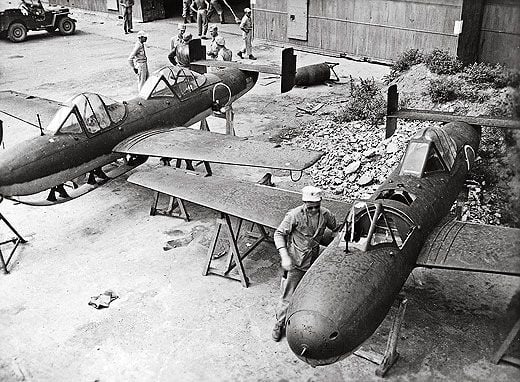The Mysterious Second Seat
Why would the Japanese need a two-seat Ohka?
/https://tf-cmsv2-smithsonianmag-media.s3.amazonaws.com/filer/In_the_museum_the_mysterious_second_seat_FLASH.jpg)
American sailors sweltering in the Pacific during World War II dreaded Japanese aerial suicide squads, or Kamikaze, whose attacks could be devastating: By the end of the war, these units accounted for seven percent of all U.S. Navy crew casualties in the Pacific theater.
While these specialized attack squadrons flew all kinds of Japanese military aircraft, in late 1944 the Imperial Japanese Navy decided to develop a type of human-guided missile to be used against American warships. And so the Ohka was created.
Pilots received little or no training before flying the Ohka. The single-seat Ohka 11 was carried underneath a mothership, and used a short-duration rocket engine assist for evasion or to accelerate toward its final target—usually an Allied warship. The Ohka 22 was able to gain a bit of extra range after separation by using an early form of a jet engine.
The only remaining Ohka 22 is on display at the Steven F. Udvar-Hazy Center in northern Virginia. But the Museum had a second Ohka, this one corroded and battered, which used to hang from the rafters of Building 2 at the Museum’s Paul E. Garber Preservation, Restoration and Storage Facility in Suitland, Maryland. “I didn’t pay too much attention to it,” admits Tom Momiyama, who has volunteered at the Museum since 1995. “To me—I’m a technical guy—it’s just a simple glider. Anyone can just wear it and fly it. So I didn’t pay that much attention. I was just looking at it like any other Ohka. Then I said, ‘Wait a minute. Why does it have two seats?’ ”
The answer he got from curators was “It’s a trainer.” But a single-seat trainer already existed; why would the Japanese navy need another version?
Momiyama, an aeronautical engineer who spent 38 years with Naval Air Systems Command Headquarters, started to do some sleuthing. He, Garber restoration specialist Bob McLean, and Malcolm Collum, the Museum’s chief conservator, have worked for the past two years to solve the mystery.
After researching archival materials in the Museum’s collections and interviewing Japanese historians and veterans of World War II, Momiyama decided that the two-seat version—the MXY7-K2 Ohka—was built for ground-based catapult training. “When you’re being catapulted,” explains Momiyama, “you go from zero to 100 knots or so. That’s different from taking off from a runway, even in a high-performance airplane. So the Japanese navy decided, Well, for that, we’d better give the pilots one check ride; that’s why they built the two-seater.”
Other accommodations were made for training. There’s evidence that a longer, low-speed wing was put on the -K2 for instruction purposes, says McLean, “so they could launch the Ohka and teach these fellows how to get off the catapult rail without killing themselves. I mean, we all knew it was a terminal mission eventually, but it would be a real tragedy losing everybody at the launch rather than at the ultimate objective.”
Only two -K2s were built. Designers modified the Ohka 11 trainer and removed one of the water-ballast tanks (used to simulate the bomb load) to accommodate a second cockpit for the instructor. To complement the solid-fuel rockets mounted on the catapult, a booster rocket was added to the tail to increase acceleration.
After the Japanese surrendered in 1945, a U.S. escort carrier transported the -K2—along with about 100 other captured Japanese aircraft—to Alameda Naval Air Station in California. And that’s where things got more mystifying.
“The Japanese painted their training and experimental aircraft an orange-yellow,” explains Momiyama. But the Ohka is painted a dark green. “One of the things that we’re still trying to decipher is when the -K2 was repainted,” says Collum.
“The outside layer of paint seems to have been applied by the U.S. Navy at some point,” says McLean. “We are interested in the chronology of the paint layers in order to correctly depict the -K2 as it might have flown.”
The fuselage is also damaged—and in a curious pattern. “When you first look at it, you wonder ‘Is this shrapnel damage?’ ” says Collum. “But then you realize that most of the damage is on one side, and none of the holes go completely through. So it’s probably from servicemen on the base walking by and just taking a swipe at the Hinomaru [the Japanese flag’s stylized sun emblem].”
The men are now looking for physical evidence or historical references that would indicate that this specific trainer actually flew. “The detective aspects of this are really thrilling,” says McLean, “but unfortunately, it doesn’t happen in real time. It happens in some other kind of altered time, and these tidbits kind of come at you from different epochs, and you just have to sit around and wait for them to come your way.”
